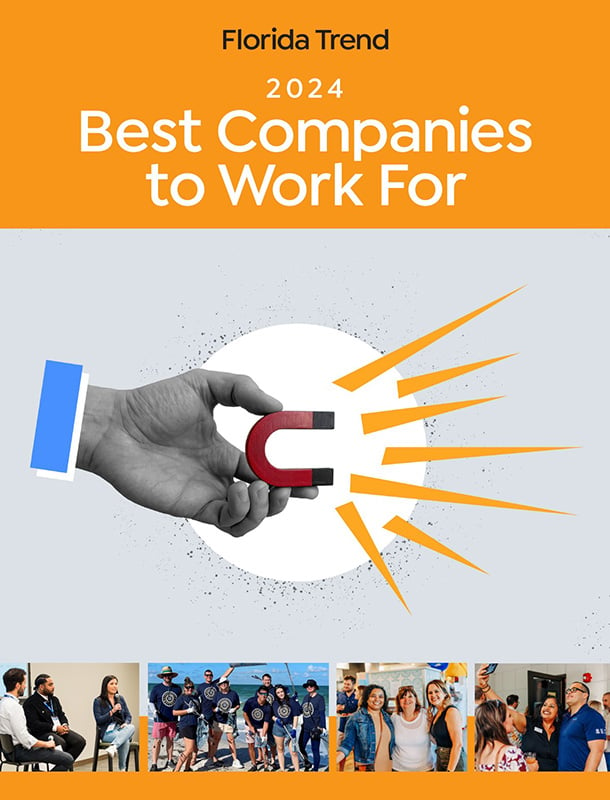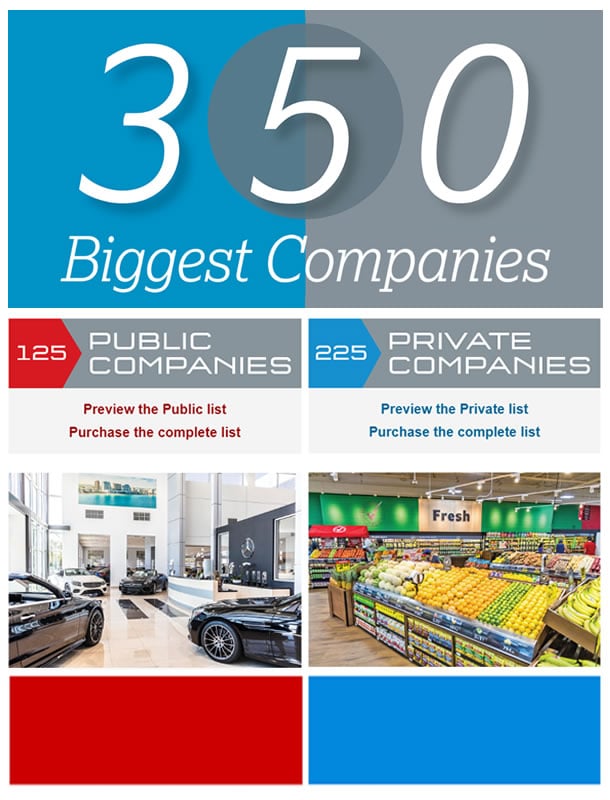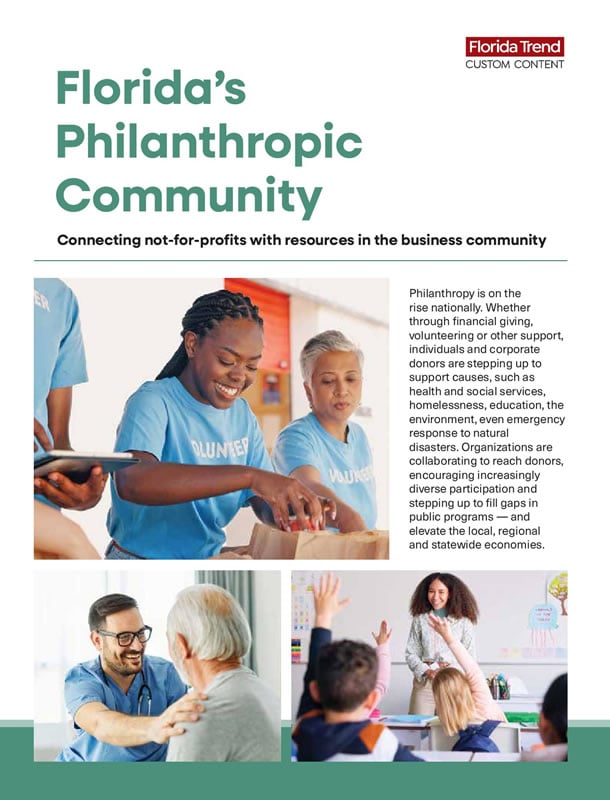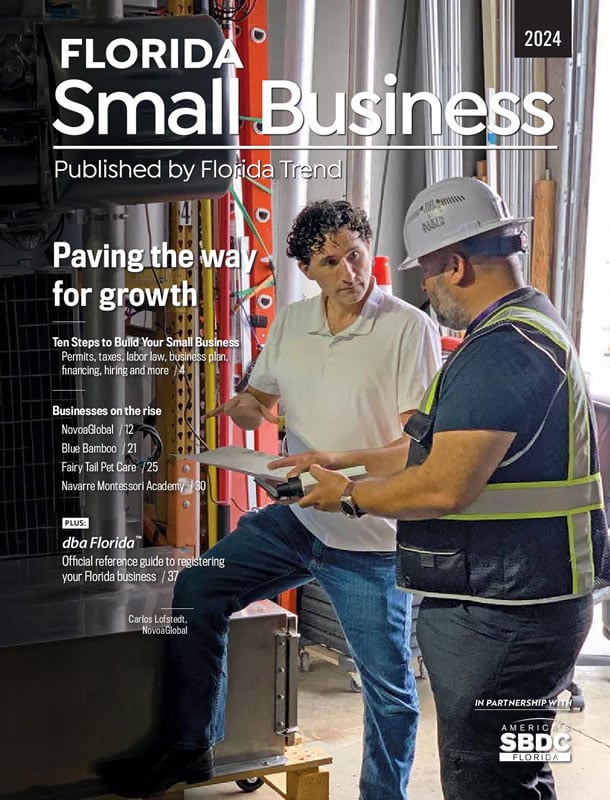"We were asked to leave a lot of banks," Durek says. "Conventional financing wasn't available at all." But the SBA was willing to gamble on the company, and through its LowDoc Loan Program, Lentek received a $100,000 loan -- and a start.
Since then, the Orlando-based Lentek, which manufactures and distributes more than 100 consumer products, has grown into a $25-million company with 40 employees. "We paid the SBA loan off in under a year," Lentine says. "Without that loan, we wouldn't have been in business."
Getting going
For startups like Lentek, or for young companies without a record of profitability, SBA loan programs are often the only way to obtain financing. Federally backed funding went to 2,375 Florida businesses via SBA programs during the fiscal year ended Sept. 30. This financial assistance to small businesses was valued at nearly $658 million, with 25% to 30% going to startups.
SBA-guaranteed loans provide opportunities to small businesses for which credit is not otherwise available, says John N. Dunn, chief of the finance division in SBA's South Florida District Office in Miami. "A single mother at home doing piecework who needs $1,000 for a sewing machine is an excellent candidate for an SBA microloan," he says. "Or a manufacturing company that has 87 employees and annual revenues of $12 million that needs a $1 million piece of machinery but doesn't have a lot of cash is also an excellent candidate for an SBA loan."
Expansion capital
Sam Leto also credits the success of his business to the SBA. Leto, president of Tampa Brass & Aluminum Corp., used SBA financing three years ago to consolidate debts and expand his company after being rejected for conventional financing because of a prior bankruptcy filing. Since then, revenues have increased 35%. "We would not have been able to grow without the SBA loan," Leto says.
The SBA does not actually fund the loans it approves; instead, for a fee, it guarantees loans submitted to it by banks. Established businesses with sufficient collateral can qualify for conventional financing. For other small businesses, however, the SBA provides a lifeline that often means the difference between success and failure of the venture.
"The SBA is doing deals that don't quite make it at the bank," says Jim Parrish, a certified business analyst at the Small Business Development Center at the University of South Florida in Tampa. "The other advantage of the SBA is that it will finance things longer than banks typically do. Your payments are lower, and the lower payment may be what allows you to qualify for a loan."
Of the numerous programs offered by the SBA, the most popular with small businesses are the 7(a) Loan Guaranty Program, the agency's primary financing program, as well as the LowDoc Loan Program and SBAExpress.
For many companies, SBA loans are the key to long-term financial health. "We had been funding everything on our credit cards, so it made a difference to have the support of the SBA," says Joe Durek. "They're there to help young companies; they caught our vision, saw that we were a company that would be putting in a lot of hard work, and they trusted us."
Strategies: Dressing Your Company for Success
Maximize the chances that your loan will be approved.
By Robyn A. Friedman
You're about to apply for a bank loan. Is there anything you can do to improve the odds of being approved on the first go-round? Absolutely, say the experts. Here's what they suggest to help make the loan approval process as painless as possible:
Dot your "i's" and cross your "t's." Submit a complete financial package to the lender. Most lenders require three years of business tax returns, a personal financial statement and business financials such as a balance sheet, income statement, cash-flow projections, accounts receivable and payable reports and earnings projections.
Write a business plan. If you don't already have one, prepare one. The Small Business Development Centers throughout the state can assist you.
Hone your "elevator speech." When you meet with the lender, you'll have just a short period of time in which to persuade the loan officer to make the loan. "You have to sell the economic viability of your proposition, and you have to sell your ability to make it happen," says Jim Parrish of the Small Business Development Center at the University of South Florida. And you'll have just minutes to do so.
Go to a bank that is familiar with SBA requirements. "Use somebody who knows the system," says John N. Dunn, finance chief for the SBA office in Miami. "Work with the banker and be in constant communication with the bank to find out the status of the application."
Pay attention to your personal credit history. The bank will consider your personal credit history in evaluating your application for a business loan, although poor personal credit won't automatically disqualify you. "If someone has what I call 'blotchy credit,' or marginal credit, that does not kick them out of the SBA program," says Lynn Johler, a senior vice president at United Bank in St. Petersburg. "But if there is derogatory credit, they should disclose that, and they'll be required to give a letter of explanation."
Establish a personal relationship with your banker. Encourage him or her to get to know you and your business. The more he or she learns about your business -- and how well you've repaid prior loans --the easier it will be to obtain financing now and in the future.
SBA Loan Programs
7(a) Loan Guaranty
The maximum loan amount under this program is $2 million, with a maximum loan guarantee of $1 million. The maximum guarantee is 85% for loans of $150,000 or less; 75% for loans over $150,000. Real estate and equipment may be financed for up to 25 years while the maximum term for working capital loans is 10 years. Guarantee fees are 2% of the guaranteed portion for loan amounts of $150,000 or less, 3% for loans from $150,000 to $700,000, and 3.5% for loans over $700,000. Loan proceeds can be used for fixed assets, working capital, inventory, seasonal line of credit or, for compelling reasons, for debt repayment.
LowDoc
This program, which streamlines the making of small-business loans, is limited to loans up to $150,000. There is a quick, two-step process. First, the borrower completes the front of SBA's one-page application, and the lender completes the back. The lender then submits the application to the SBA and receives a response within 36 hours. The maximum SBA guarantee is 85%.
SBAExpress
Lenders use their own forms and processes to approve loans in amounts up to $150,000, providing minimal paperwork to the SBA to obtain a maximum guarantee of 50%. The loan maturity is generally five to 10 years, but terms up to 25 years are allowed for fixed-asset loans.
Microloans
This program provides very small loans to startup, newly established or growing small businesses. Funds are available through nonprofit community-based lenders. The maximum loan amount is $35,000. Applications are submitted to the participating local lender. The maximum term is six years.












